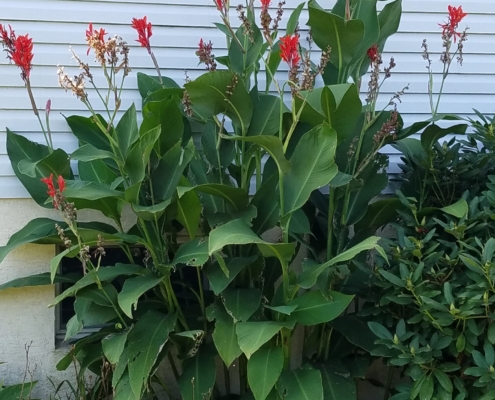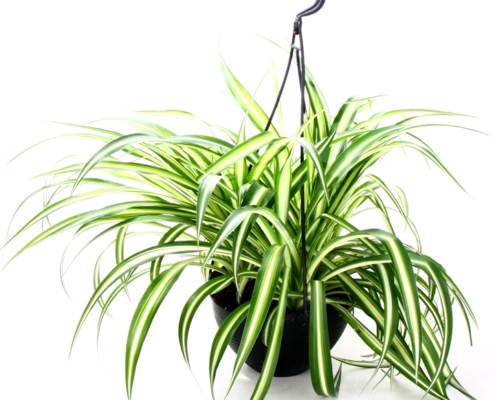Dig Canna, Dahlia and Caladium
Some of our favorite summer show-stoppers like Cannas, Dahlias and Caladiums, need to be dug up in the fall for overwintering. It isn’t a difficult job and you’ll be rewarded with larger and larger plants every year. You’ll also get more of them. That’s how these plants spread. Besides, it feels good to be outside on a crisp fall day wearing that faded out sweatshirt you love. Let someone else rake the leaves while you divide and conquer.

Canna
Cannas are amazing planted in the ground. And, rising three to five feet tall, they can really elevate large container combinations. Their rhizomes are modified roots that store the plant’s energy for the next year. The rhizomes of a happy canna can easily double in size after one growing season. Just imagine how showy they’ll be next year.
Digging
In late fall, when the stems and leaves have died back or been killed by the first hard frost, is the perfect time to lift them. Make sure to do it before the ground freezes. First, cut stems back to two inches. Then, use your shovel to cut a circle at least two feet in diameter around the plant’s rhizomes, and gently lift the clump. Using your hands, shake off all the excess soil. If the soil is sticking to the rhizomes, rinse them with the hose until they’re fairly clean.
Drying and Storing
Pick a spot in your garage, basement or someplace dark with good ventilation. It should be at least 70 degrees F. Spread them out on several layers of newspaper. Let them dry for at least a week, it helps to discourage mold. Now they are ready to store. Use paper grocery bags or crates, something that allows airflow to put them in. Look for a cool (but not freezing) dark place to store them like a basement or a garage. Check them now and again to make sure none are shriveled or mushy, discard those as soon as possible.
Planting
Plant the following spring after the threat of frost has passed and the soil has begun to warm. Always add Espoma’s organic Bulb-tone when planting to give them the specialized nutrients they’ll need to flourish.

Dahlias
Dahlias come in hundreds of shapes, heights, sizes and colors. Besides being superstars in the garden they make excellent cut flowers. Some flowers are dinner plate sized and many reach four to five feet in height. They enjoy full fun in moderate climates. Prepare to be wowed!
Lifting
After the first frost, cut the dahlias back to four inches and dig the clumps just like you would have for cannas. The tubers are breakable so, go slow and gently shake off extra soil. No need to rinse them. Let the clumps air dry for several days in a dark place with good ventilation.
Storing
You can pack dahlia tubers several ways. Planting them in large nursery pots with damp soil is one way. Storing them in cardboard boxes, filled partially with damp potting soil, peat moss or vermiculite will also work. It’s also possible to store several clumps in large black plastic bags. Gather the top of the bags loosely so there is still some air circulation. Store in a cool dark place that does not freeze. A frozen tuber is a dead tuber. Check on them now and then, go easy on the water since you don’t want them to be too moist. If they are dry, you can mist them or add some damp organic potting mix.
Planting
In the spring, divide the clump into several with some of last year’s stem. Plant outdoors after the threat of frost has passed and add Bio-tone Starter Plus to help them get a good start.

Caladium
Caladiums are popular for their large foliage in shades of white, red and pink, often in wild mosaic patterns. They like shade to part sun, making them perfect for displaying in less than sunny spots in the garden. There are now a few varieties that are sun tolerant. It will say so on the plant tag. While they do thrive in sun, regular, perhaps even daily watering will be needed.
Lifting
When temperatures begin to fall below 60 degrees F, dig up tubers and leave stems attached. You don’t need to remove all of the soil just yet. Leave them to dry in a cool, dark space for two to three weeks.
Storing
After the tubers have cured, brush off the remaining soil and cut back the withered stems. Store them in a cool dark space. Packing them in sawdust or sand will help keep them from drying out too much.
Planting
You can plant them outside after the threat of frost has passed and the ground has warmed up. They can also be started early indoors. Just pot them up on a good quality potting soil like Espoma’s organic potting mix and give them some Bulb-tone to give them the best possible start.
Here are links to some of our other blogs we hope you will enjoy.
Get Easy Blooms with Spring Planted Bulbs
5 Reasons to Start a Cutting Garden
Winter is Coming – Frost Preparedness
Espoma Products





















